Linden D., Reddy T.B. (eds.) Handbook of batteries
Подождите немного. Документ загружается.

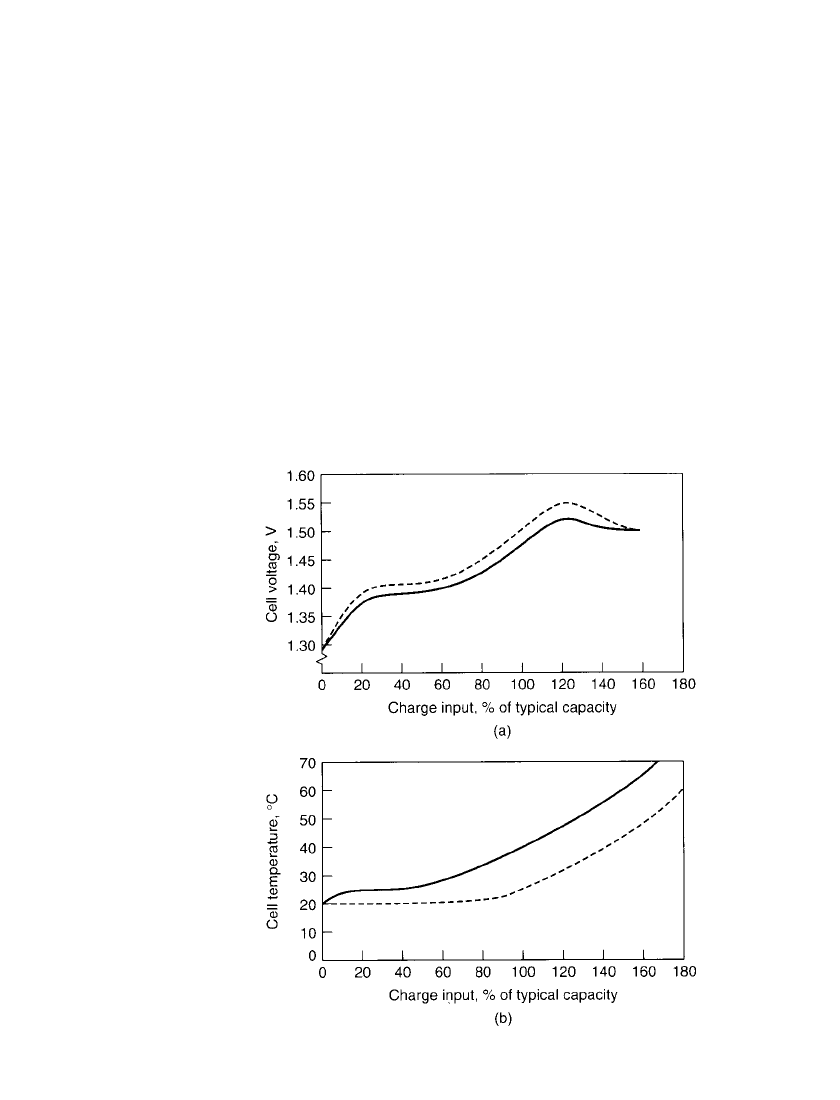
29.22 CHAPTER TWENTY-NINE
FIGURE 29.16 Comparison of typical charge characteristics of
nickel-cadmium and nickel-metal hydride batteries: (a) Voltage
characteristics. (b) Temperature characteristics. Solid line—
Ni-MH: broken line—NiCd. (Courtesy of Duracell, Inc.)
The recharging characteristics of the nickel-metal hydride battery are generally similar to
those of the sealed nickel-cadmium battery. There are some distinct differences, however,
particularly on the requirements for charge control, as the metal hydride battery is more
sensitive to overcharge. Caution should be exercised before using the same battery charger
interchangeably for both types of batteries.
The most common charging method for the sealed nickel-metal hydride battery is a con-
stant-current charge, but with the current limited to avoid an excessive rise of temperature
or exceeding the rate of the oxygen-recombination reaction.
The voltage and temperature profiles of the nickel-metal hydride and the nickel-cadmium
batteries during charge at a moderate constant-current charge rate are compared in Fig. 29.16.
The voltage of both battery systems rises as the battery accepts the charge. During the first
phase of the charge, the temperature of the nickel-cadmium battery remains relatively con-
stant because its charge reaction is endothermic. The temperature of the nickel-metal hydride
battery, on the other hand, rises gradually because its charge reaction is exothermic. As the
batteries approach 75 to 80% recharge, the voltage rises more sharply due to the generation
of oxygen at the positive electrode, and the temperature, in both cases, rises due to the
exothermic oxygen-recombination reaction. This increase in cell temperature causes the volt-
age to drop as the battery reaches full charge and goes into overcharge.

PORTABLE SEALED NICKEL-METAL HYDRIDE BATTERIES 29.23
FIGURE 29.17 Cell voltage vs. charge input for sealed cylindrical nickel-metal hydride batteries.
(a) At various temperatures (charge rate 0.3C ). (b) At various charge rates at 20⬚C.
FIGURE 29.18 Battery temperature during charge of nickel-metal hydride
cylindrical batteries.
The voltage profile of the nickel-metal hydride battery does not show as prominent a
peak as that of the nickel-cadmium battery. Second, while the temperature of both batteries
increases as the batteries reach full charge due to the oxygen-recombination reaction, during
overcharge the temperature of the nickel-cadmium battery levels off at reasonable charge
rates while the temperature of the nickel-metal hydride battery continues to rise. Both the
voltage drop after peaking (
⫺⌬V) and the temperature rise can be used as methods to ter-
minate the charge. However, while similar charge techniques can be used for both types of
batteries, the conditions to terminate the charge may differ because of the different behavior
of the two battery systems during charge.
The voltage of the sealed nickel-metal hydride battery during charge depends on a number
of conditions, including charge current and temperature. Figure 29.17 shows the voltage
profile of the nickel-metal hydride battery at different charge rates and temperatures. The
voltage rises with an increase in charge current due to a higher IR and overpotential during
the electrode reaction. The voltage decreases with increasing temperature as the internal
resistance and the overpotential during electrode reaction decreases. The voltage peak is not
as evident at the low charge rates and at the higher temperatures.
The increase in battery temperature during the charge at various charge rates is shown in
Fig. 29.18. The internal cell pressure increases similarly. This rise in temperature and pres-
sure at the higher charge rates emphasizes the need for proper charge control and effective
charge termination when ‘‘fast charging’’ to avoid venting and other deleterious effects.
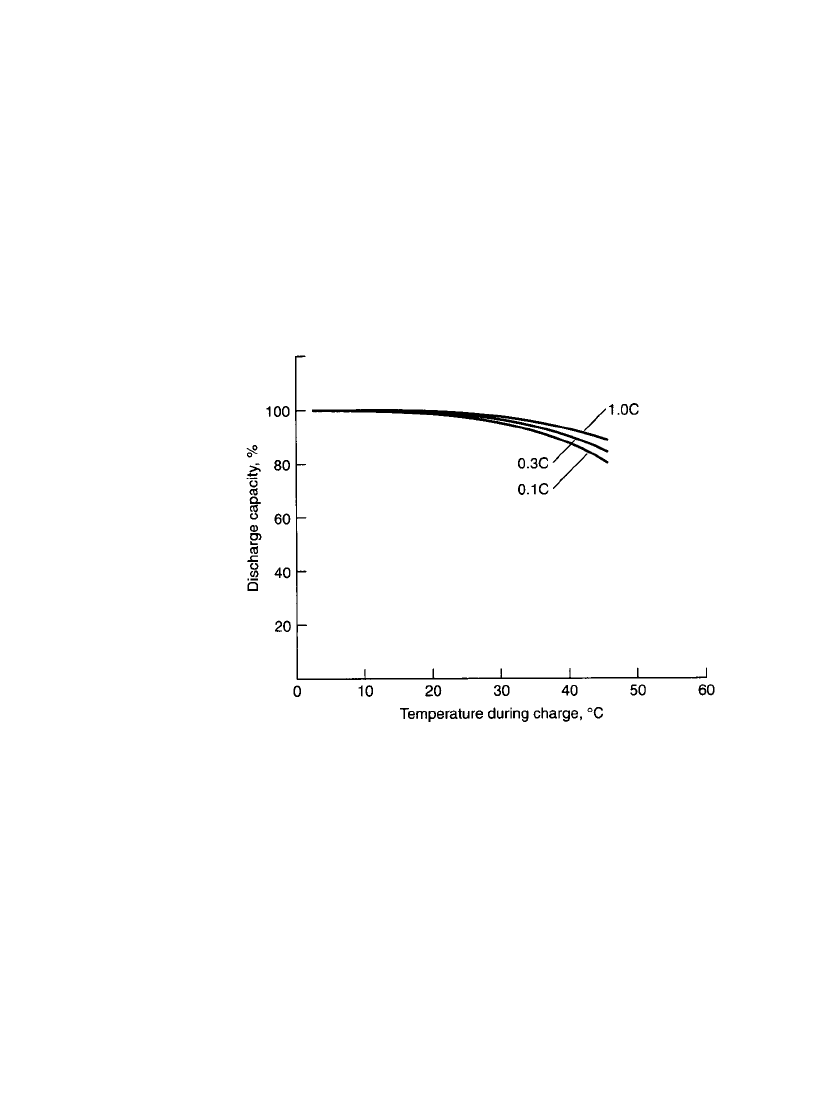
29.24 CHAPTER TWENTY-NINE
The charge efficiency is also dependent on temperature. It decreases at the higher tem-
peratures due to the increasing evolution of oxygen at the positive electrode. At the lower
temperatures, charge efficiency is high due to decreasing oxygen evolution. However, at the
lower temperatures, oxygen recombination is slowed down and a rise in internal cell pressure
may occur depending on the charge rate. Figure 29.19 shows the available discharge capacity
following charging at various temperatures and several charge rates. As shown, the battery
capacity is reduced after high-temperature charging. The extent of this effect is also depen-
dent on the conditions of the discharge following the charge, as well as on other charge
conditions.
Proper recharging is critical not only to obtain maximum capacity on subsequent dis-
charges, but also to avoid high temperatures, overcharge, and other conditions which could
adversely affect battery life.
FIGURE 29.19 Charge efficiency vs. charge temperature at various
charge rates for sealed cylindrical nickel-metal hydride batteries. Dis-
charge at 0.2C rate to 1.0 V.
29.5.2 Techniques for Charge Control
The characteristics of the nickel-metal hydride battery define the need for charge control to
terminate the charge to prevent the battery from being overcharged or exposed to high
temperatures. The advantage of employing proper charge control to maximize the life of the
battery is illustrated in Fig. 29.20. The highest capacity levels are achieved with the 150%
charge input, but at the expense of the cycle life. the longest cycle life is attained with the
120% charge input, but with lower capacity due to insufficient charge input. Thermal cutoff
charge control may reduce cycle life because the battery is usually allowed to reach higher
temperatures during the charge. This method, however, is useful as a backup control in the
event that the maximum temperature is exceeded during the charge.
Some of the popular methods for charge control are summarized hereafter. The charac-
teristics of these methods are illustrated in Fig. 29.21. In many cases several methods are
used, during a single charge, particularly to control high-rate charging.

PORTABLE SEALED NICKEL-METAL HYDRIDE BATTERIES 29.25
FIGURE 29.20 Effect of charge control on cycle life of sealed cylindrical nickel-metal hydride batteries.
1C charge rate: discharge at 1C to 1.0 V. TCO—charge termination at 40⬚C; 120%—charge termination at
120% charge input; 150%—charge termination at 150% charge input. (Courtesy of Duracell, Inc.)
FIGURE 29.21 Comparison of charge termination methods: TCO,
⌬T / ⌬t, and ⫺⌬V.
Timed Charge. Under this charge control method the charge is terminated after the battery
has been charged for a predetermined amount of time. This method should only be used for
charging at low rates to avoid excessive overcharge because the state of charge of the battery,
prior to charging, cannot always be determined. This procedure is also used as a ‘‘topping’’
charge to other charge termination methods to ensure a complete recharge.
Voltage Drop (
ⴚ⌬V). With this technique, widely used with sealed nickel-cadmium bat-
teries, the voltage during charge is monitored and the charge is terminated when the voltage
begins to decrease. This approach can be used with the nickel-metal hydride battery, but as
noted in Sec. 29.5.1, the peak with the metal hydride cell is not as prominent and may be
absent in charge currents below the 0.3C rate, particularly at elevated temperatures. The
voltage signal must be sensitive enough to terminate the charge when the voltage drops, but
not so sensitive that it will terminate the charge prematurely due to noise or other normal
voltage fluctuations. A 10-mV per cell drop is generally used for the nickel-metal hydride
battery.

29.26 CHAPTER TWENTY-NINE
Voltage Plateau (0⌬V ). As the sealed nickel-metal hydride battery does not always show
an adequate voltage drop, an alternate method is to terminate the charge when the voltage
peaks and the slope is zero rather than waiting for the voltage to drop. The risk of overcharge
is reduced as compared to the
⫺⌬V method. A topping charge can follow to ensure a full
recharge.
Temperature Cutoff (T). Another technique for charge control is to monitor the temper-
ature rise of the battery and terminate the charge when the battery has reached a temperature
which indicates the beginning of overcharge. It is difficult to determine this point precisely
as it is influenced by ambient temperature, cell and battery design, charge rate, and other
factors. For example, a cold battery may be overcharged before reaching the cutoff temper-
ature while a warm battery may be undercharged. Usually this method is used in conjunction
with other charge control techniques and mainly to terminate the charge in the event the
battery reaches excessive temperatures before the other charge controls activate.
Delta Temperature Cutoff (
⌬T). This technique measures the battery temperature rise
above the ambient temperature during charging and terminates the charge when this rise
exceeds a predetermined value. In this way, the influence of ambient temperature is mini-
mized. The cutoff value is dependent on several factors, including cell size, configuration
and number of cells in the battery, and the heat capacity of the battery. Therefore, the cutoff
value must be determined for each type of battery.
Rate of Temperature Increase (
⌬T/ ⌬t). In this method, the change in temperature with
time is monitored and the charge is terminated when a predetermined incremental temper-
ature rise is reached. The influence of ambient temperature is virtually eliminated. A
⌬T/ ⌬t
cutoff is a preferred charge control method for nickel-metal hydride batteries because it
provides long cycle life.
Note: Details on the design of batteries using protective devices and a description of the
thermal protective devices that can be used for charge control are discussed in Chap. 5.
29.5.3 Charging Methods
Sealed nickel-metal hydride batteries can be charged by several methods, ranging from low
rate to fast charging, provided the change is controlled to prevent damaging effects.
Low-Rate Charge. A convenient method to fully charge sealed nickel-metal hydride bat-
teries is to charge at a constant current at about the 0.1C rate with time-limited charge
termination. At this current level the generation of gas will not exceed the oxygen-
recombination rate. The charge should be terminated after 150% capacity input (approxi-
mately 15 h for a fully discharged battery). Excessive overcharge should be avoided as this
can be injurious to the battery. The temperature range for this charge method is 5 to 45
⬚C,
with best performance being obtained between 15 and 30
⬚C.
Quick Charge (4–5 h). Nickel-metal hydride batteries can be recharged efficiently and
safely at higher rates. Charge control is required in order to terminate the charge when the
rate of oxygen recombination is exceeded or the battery temperature rises excessively. The
fully discharged battery can be charged at the 0.3C rate for a charge time equivalent to a
150% charge input (approximately 4.5 to 5 h). In addition to the timer control, a thermal
cutoff device should be used as a backup control to terminate the charge at about 55 to 60
⬚C
to avoid exposing the battery to excessively high temperatures. This charging method may
be used in an ambient temperature range of 10 to 45
⬚C.
As a further precaution, the decrease in voltage
⫺⌬V should also be sensed to ensure that
the charge is terminated early enough to minimize overcharge. This is particularly advisable
if the battery being charged was not fully discharged. A ‘‘topping’’ charge at the 0.1C rate,
as described, may then be used to assure 100% recharge.
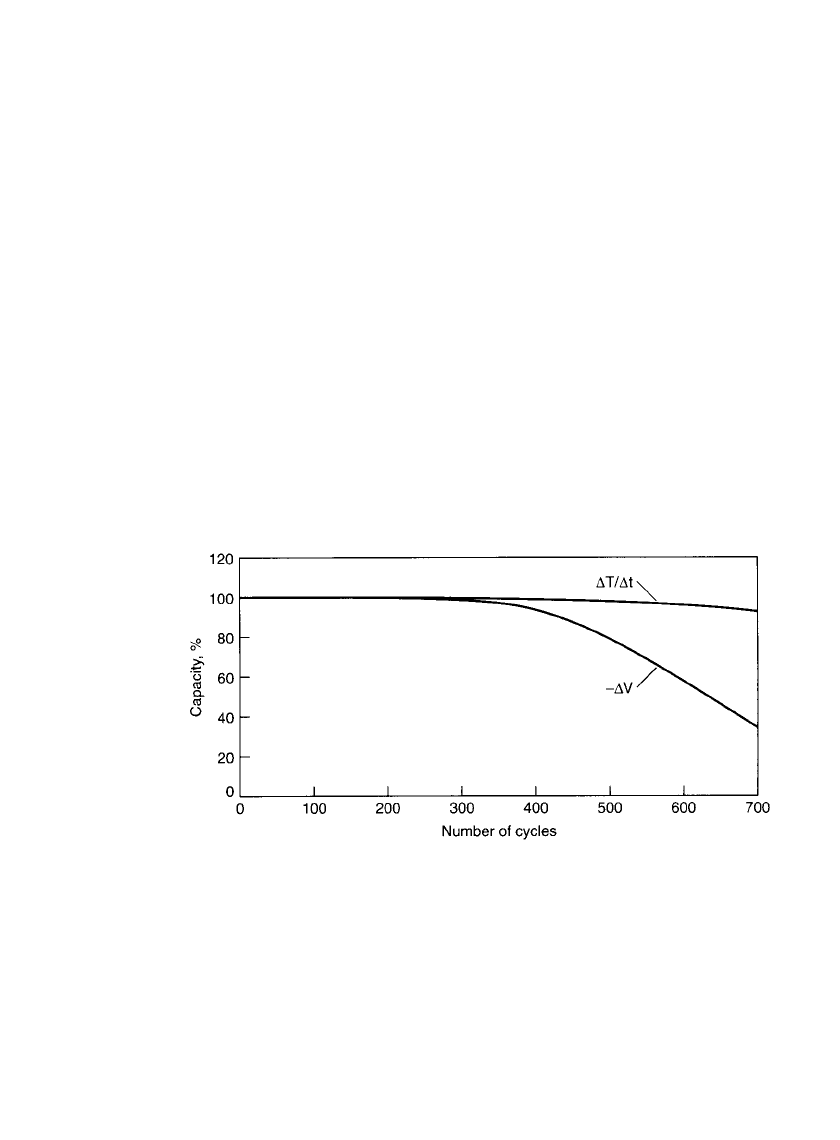
PORTABLE SEALED NICKEL-METAL HYDRIDE BATTERIES 29.27
Charging sealed nickel-metal hydride batteries at rates between 0.1 and 0.3C generally is
not recommended. At these rates the voltage and temperature charge profiles may not exhibit
characteristics suitable for voltage-based cutoff control and the batteries may otherwise be
exposed to harmful overcharge.
Fast Charge (1 h). Another method of charging nickel-metal hydride batteries in an even
shorter time is to charge at a constant current at the 0.5 to 1C rates. At these high charge
rates it is essential that the charge be terminated early during overcharge. Timer control is
inadequate as the time needed for charge cannot be predicted. A partially charged battery
could easily be overcharged while a fully discharged one could be undercharged, depending
on how the timer control is set.
With fast charging, the decrease in voltage
⫺⌬V and the increase in temperature ⌬T can
be used to terminate the charge. For better results, termination of fast charge can be con-
trolled by sensing the rate of temperature increase
⌬T/ ⌬t with a thermal cutoff (TCO)
backup.
Figure 29.22 shows the advantage of using a
⌬T/ ⌬t method compared to ⫺⌬V in ter-
minating a fast charge. The
⌬T/ ⌬t method can sense the start of the overcharge earlier than
the
⫺⌬V method. The battery is exposed to less overcharge and overheating, resulting in
less loss of cycle life. A temperature increase of 1
⬚C/ min should be used for ⌬T /⌬t;a
temperature of 60
⬚C is recommended for the TCO.
In the case of multicell batteries of three cells or more,
⫺⌬V termination with TCO
backup may be adequate. The
⫺⌬V value usually is 10–15 mV per cell and 60⬚C for the
TCO.
FIGURE 29.22 Cycle life and capacity as a function of charge termination method for
sealed cylindrical nickel-metal hydride batteries. Charge 1C; rest 0.5 h; discharge, 1–0
V; rest 2 h. (Courtesy of Duracell, Inc.)
Trickle Charge. A number of applications require the use of batteries which are maintained
in a fully charged condition. This is done by trickle charging at a rate that will replace the
capacity loss due to self-discharge. A trickle charge at a current of between the 0.03 and
0.05C rates is recommended. The preferred temperature range for trickle charging is between
10 and 35
⬚C. Trickle charge may be used following any of the previously discussed charging
methods.
Three-Step Charge Procedure. A three-step procedure provides a means of rapidly charg-
ing a sealed nickel-metal hydride battery to full charge without excessive overcharge or
exposure to high temperatures.

29.28 CHAPTER TWENTY-NINE
1. The first step is a charge at the 1C rate terminated by using the ⌬T/⌬t method or the
⫺⌬V method.
2. This is followed by a 0.1C topping charge, terminated by a timer after
⫺ 1 h of charge.
1
–
2
3. The third step is a maintenance charge of indefinite duration at a current of between the
0.05 and 002C rates. The battery should also be protected with a thermal cutoff device
to terminate the charge so that the temperature does not exceed 60
⬚C.
29.5.4 Smart Batteries
Battery technology has evolved to a point now where batteries are often termed ‘‘smart,’’
indicating that a certain level of electronics has been installed within the battery. These
controls can provide information on the battery’s condition and ‘‘state of charge,’’ can control
charging and provide data on discharge which can improve service life. Nickel-metal hydride
batteries benefit from this because of the difficulty in reaching a full charge under a wide
range of operating conditions. Inefficiencies during charge at the positive electrode make it
difficult to estimate when to stop charging. The tendency is to charge longer than needed,
and the result is higher end-of-charge temperatures. The ‘‘smart’’ electronics ‘‘act’’ by mea-
suring the amount of current being drawn, the temperature, the charge rate, etc. Using a
calibration of the chemistry and design peculiar to the manufacturer, the amount of charge
accepted by the battery can be estimated to about 1% and the charge can be terminated at
the proper point.
5
The digital electronics can also estimate discharge time using similar calibration tables
based on the discharge curves and other relevant data. This information is then displayed as
lighted LEDs or communicated over a serial bus to electronics in the laptop computer, for
example, for display or control of the device. A typical set of calibration curves is shown
in Fig. 29.23. It shows the values used to calculate the charge lost (self-discharge) as a
3.5
3
2.5
2
1.5
1
0.5
0
90
80
70
State of charge (%)
60
50
40
10
35
Temperature
(°C)
45
Self-Discharge (% per day)
FIGURE 29.23 Characterization of rate of self-discharge for sealed
nickel-metal hydride batteries. Self discharge rate vs state of charge and
temperature (from reference 6).

PORTABLE SEALED NICKEL-METAL HYDRIDE BATTERIES 29.29
function of standtime, temperature and state-of-charge. This information and other relevant
data on the battery’s characteristics are used in an algorithm to display available capacity,
remaining hours of service or the amount of recharge required to achieve a full charge
5
(see
Chap. 5 for more details on smart batteries).
29.6 CYCLE AND BATTERY LIFE
29.6.1 Cycle Life
The cycle life of nickel-metal hydride batteries, as all rechargeable batteries, depends on the
many conditions to which the battery has been exposed, such as:
•
Temperature during charge and discharge
•
Depth of discharge
•
Charge and discharge current
•
Method of charge control
•
Exposure to overcharge and overdischarge
•
Storage conditions and length of storage
Typically under a standard charge-discharge cycle at the 0.2C rate and at normal ambient
temperature (20
⬚C), about 500 cycles can be achieved with the battery delivering at least
80% of its rated capacity. This is illustrated in Figs. 29.20 and 29.22. The gradual reduction
in capacity results from an increase in the cell’s internal resistance due to minor irreversible
changes in the electrode structures and loss of electrolyte or cell dry-out. The increase in
internal resistance is illustrated in Fig. 29.24, which shows the gradual decrease in midpoint
voltage during discharge (Fig. 29.24a) and the gradual increase in voltage during charge
with cycling (Fig. 29.24b).
For optimum battery and maximum cycle life, the nickel-metal hydride battery should be
operated near room temperature. Operation at extreme temperatures during charge or dis-
charge will adversely affect its performance, as shown graphically in Fig. 29.25. Operation
at high temperatures, particularly in the overcharge condition, can cause the cell to vent,
releasing gas and possibly electrolyte through the safety vent. High temperatures will also
hasten the deterioration of the separator and other materials in the cell. At low temperatures
the oxygen-recombination reaction slows down, the cell is more sensitive to overcharge, and
gas pressure will build up more rapidly.
The charge rate and the amount of charge input during overcharge also are important
factors affecting the cycle life. If the battery is charged at a rate that exceeds the oxygen-
recombination rate, oxygen that is generated during overcharge will not be reacted and gas
pressure and temperature will build up with deleterious effects on battery and cycle life. The
more effective the method to terminate the charge promptly when deleterious overcharge
begins, the less is the effect on cycle life. This was also illustrated in Figs. 29.20 and 29.22.
Finally cycle life is also affected by the depth of discharge. About 500 cycles can be
obtained, depending on the charge termination method, with the battery being fully dis-
charged on each cycle (100% depth of discharge). Considerably higher cycle life can be
obtained if the battery is cycled on shallower charges and discharges. Figure 29.26 shows
the increase in cycle life on a shallow charge-discharge. In this example the battery is dis-
charged at the 0.25C rate to about a 60% depth of discharge. The cycle life is increased to
about 1000 cycles. Shallower discharges will further increase the cycle life.
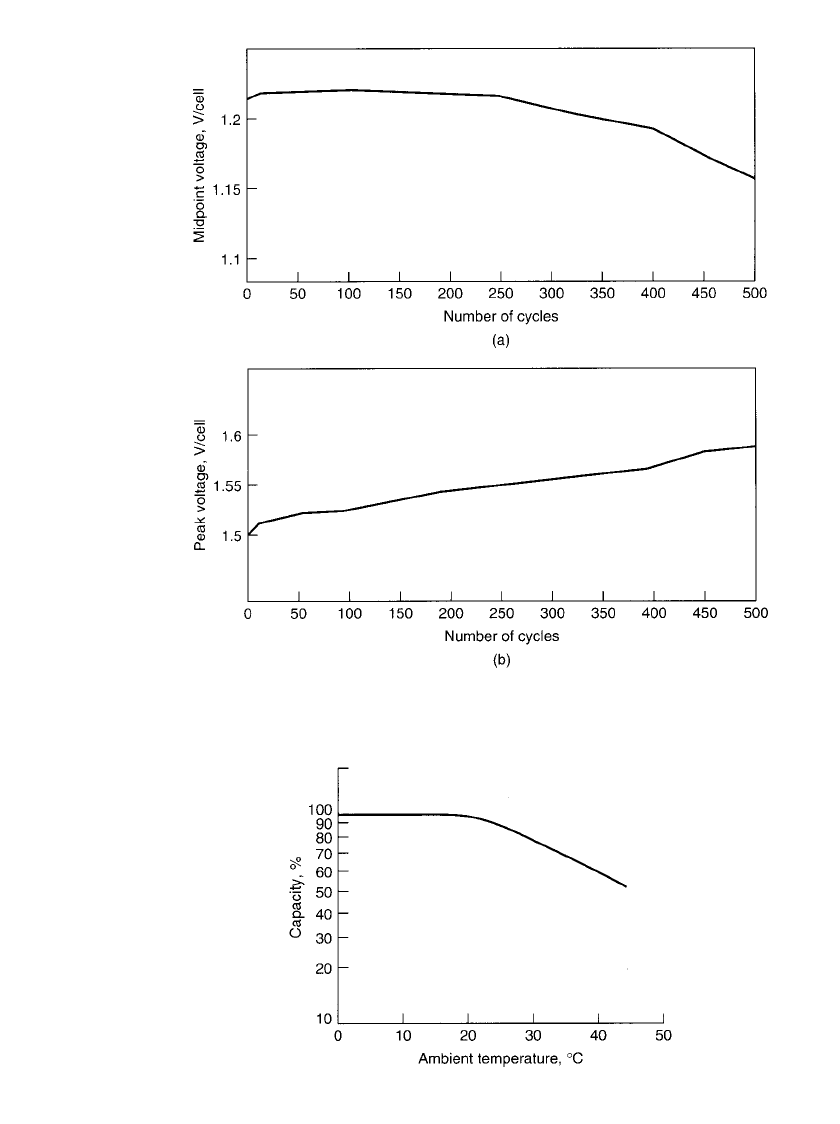
29.30 CHAPTER TWENTY-NINE
FIGURE 29.24 Effect of cycling on voltage characteristics of sealed cylindrical nickel-
metal hydride batteries. (a) Decrease in midpoint voltage with cycling. (b) Increase in
maximum voltage during charge with cycling. (Courtesy of Duracell, Inc.)
FIGURE 29.25 Effect of ambient temperature on cycle
life of sealed cylindrical nickel-metal hydride batteries.
(Courtesy of Duracell, Inc.)
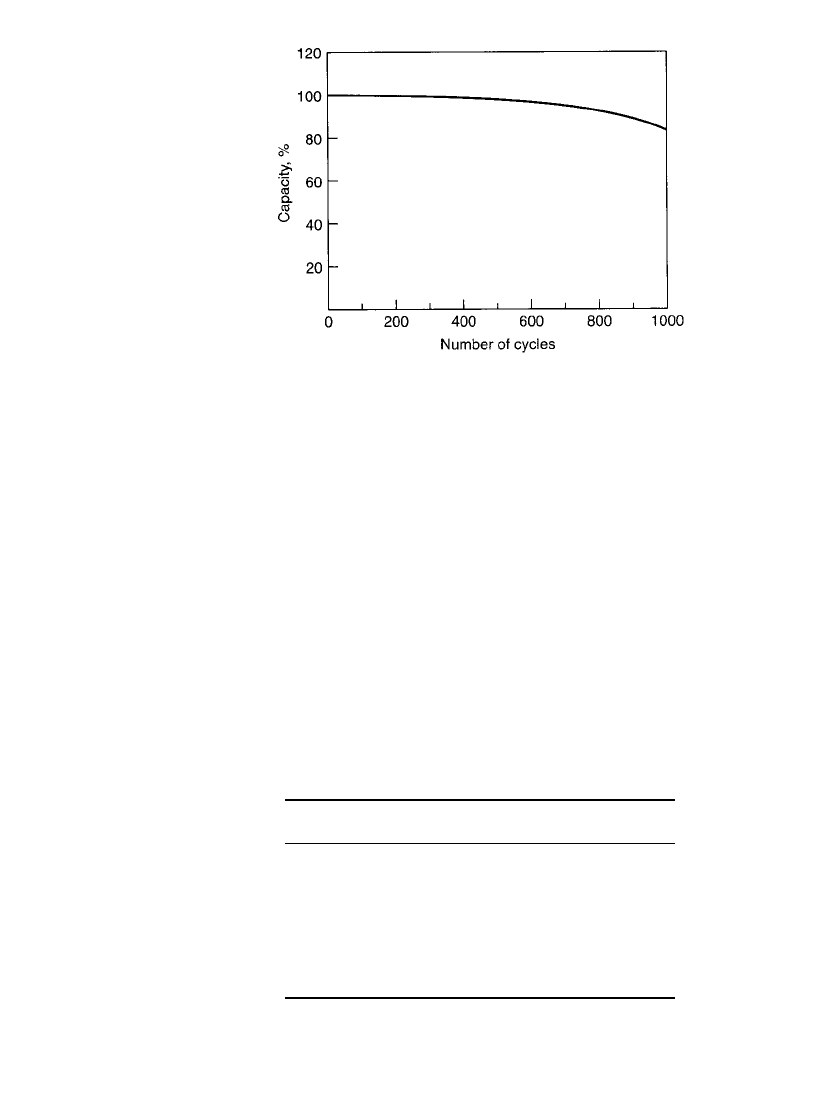
PORTABLE SEALED NICKEL-METAL HYDRIDE BATTERIES 29.31
FIGURE 29.26 Effect of depth of discharge on cycle life at
20⬚C for sealed cylindrical nickel-metal hydride batteries. Cy-
cle conditions: charge 0.25C, 3.2 h; discharge 0.25C, 2.4 h.
Capacity measurement: charge 0.3C, 5 h, every 50 cycles, dis-
charge 0.3C, 5 h. (Courtesy of Duracell, Inc.)
29.6.2 Battery Life
The same factors that affect cycle life affect overall battery life. Operation or storage at
extreme temperatures, overcharging, cell venting, and abuse will reduce battery life. For
optimum life, operation and storage should be as close to normal temperatures (20
⬚C) as
possible. Recommended and permissible temperature limits are shown in Table 29.3.
TABLE 29.3 Recommended Temperature Limits for
Use of Sealed Nickel-Metal Hydride Batteries
Recommended Permissible
Standard change 15 to 30⬚C 0 to 45⬚C
Quick charge 10 to 30
⬚C 10to45⬚C
Fast charge 10 to 30
⬚C 10to45⬚C
Trickle charge 10 to 30
⬚C 10to35⬚C
Discharge 0 to 40
⬚C ⫺20 to 60⬚C
Storage, charged 10 to 30
⬚C 10to35⬚C
Storage, discharged 10 to 30
⬚C 10to35⬚C
